

Mother Cultures and Patriarchal Indo-Europeans
![]()
The following information is part of a book which I researched and published online. I thought perhaps others might like a wee bit of some of the background information that I briefly mention concerning the Historical Baggage line.
Soon to be published in the fall, is a new book, specific
to the Mother Cultures and the
Patriarchal Indo-Europeans -
Historical Baggage: The Book, Healing History.
Let me preface this section by stating that I am in no way advocating a goddess religion, as opposed to a patriarchal religion. I am advocating the search for the truth. I am pointing out the PIE elements that created both goddesses and gods; pointing out facts that come into play, involving the aspect of women, either from those that are the mother in a family unit, clan mother, tribe mother or what became goddesses. We can not understand what all is taking place in our culture, without the proper foundation, whether that is history, linguistics, archaeology, etc.
A number of scholars have stated how difficult it is, in prehistory times (recorded history), to determine what was religion, from what was a cultures everyday way of life. When all you have are artifacts, artwork, some symbols, how can you tell if a jar was used daily or if that daily use was also ritual? In most cases, you cant. There are many images that have been found from Old Europe, ancient Anatolia area, the Middle East and the Aegean territories, which predate a written history and do not have inscriptions. These images are of women, particularly women that are pregnant or nursing, women who have borne children and are not so thin and firm anymore. “The pervasiveness of the veneration of the Mother-Goddess in the Neolithic and Chalcolithic periods has been confirmed by archaeological data. Marija Gimbutas reports that approximately 30,000 miniature sculptures in clay, marble, bone, copper, and gold are presently known from a total of 3000 sites in southeastern Europe alone and that these testify to the communal worship of the Mother-Goddess. Gimbutas shows, by means of archaeological evidence, that the Neolithic cultural symbols survived into the third millennium B. C. in the Aegean area and into the second millennium B. C. in Crete…We find such a figure in the lowest layers of the excavations of Catal Huyuk, at the level of the seventh millennium B. C., in the form of the pregnant, the birthing goddess…Similar figurines have been found in sites in the Dom valley of Russia, in Iraq, Anatolia, in Ninevah, Jericho, and in Southern Mesopotamia.” The Creation of Patriarchy, pgs. 146, 147. “Thus, in surreal assemblages which bring evidence of the world of the imagination, there are ideas of fertility, of maternity, of royalty and of being the mistress of wild animals. Here are all the traits of the Mother-Goddess who dominates the oriental pantheon right up to the time of the male-dominated monotheism of Israel.” The Birth of the Gods and the Origins of Agriculture, pgs. 29, 31.
Unfortunately, many men (archaeologists, anthropologists, scholars) automatically designated these images as goddesses, as opposed to later images of known male deities with inscriptions and temples. Some of these images were called Venus figurines, after the Roman goddess of love, obviously associating them with fertility. Yet, those images cannot be stated with certainty to be goddesses, as some more modern scholars have conceded and even pointed out. “The term
Paleolithic Venus’ by which the small ancient figurines were first characterized by scholars is obviously an ironic misnomer. ‘Venus,’ commonly understood as the apotheosis of erotic beauty, as personified by the Indo-European Goddess of Dawn and Love, is a concept which by no means fits the prehistoric portrayals of women. Paleolithic as well as subsequent engravings, reliefs, and sculptures frequently represent the female body in forms which seem to us absurdly abstract or absurdly grotesque – so deformed or unrealistically exaggerated as to have been termed ‘monstrous’ by some pre-historians and art historians. Only in the recognition of the presence of a preeminent deity is the class term ‘Venus’ justified.” In All Her Names, Marija Gimbutas, Edited by Joseph Campbell and Charles Muses, pg. 25. “However, myths as well as names, actions, and functions of different divine forces worshipped by prehistoric people will never be known, regardless of how plausible some ‘interpretations’ might be. Unfortunately, myths of prehistoric societies are often ‘created’ by modern authors. For example, there is almost an obsession with the universality of ‘Mother Goddess’ (Gimbutas 1989) and / or fire/ sun/ fertility (Singh 1993) worship in prehistoric societies. Almost each and every prehistoric artifact which cannot be easily classified as domestic in its function is frequently interpreted in symbolic terms related to religion. …But before we can assume the meaning of prehistoric symbols, many variables, often not related to religion, have to be taken into consideration.” Creation Stories of the Middle East, Ewa Wasilewska, pg. 10.
Nor can it be stated that these “goddesses” were in temples or shrines. “In any case, the great majority of Old European figurines have been found in domestic contexts in and around houses. Ordinarily they do not seem to have been separated from the flow of daily activities or segregated in shrines, so looking for shrines is perhaps the wrong way to understand them.” The Lost World of Old Europe, David Anthony, pg. 42. One of the major scholars contributing to the goddess terminology was Marija Gimbutas, an archaeologist, whose works have been quoted by other scholars tremendously. “The term ‘Great Goddess’ does not refer to a female version of the transcendent monotheistic God. Gimbutas defines ‘Goddess,’ in all her manifestations, as a symbol of the unity of all life in Nature. ‘Her power was in water and stone, in tomb and cave, in animals and birds, snakes and fish, hills, trees, and flowers. Hence the holistic and mythopoetic perception of the sacredness and mystery of all there is on Earth.’ The cosmogonic Goddess is ultimately a metaphor, a sacred concept of the immanent Source of all existence rendered, for thousands of years, in female forms.” The Body of Woman as Sacred Metaphor, Joan Marler, pg. 9, 2003. So regardless of Gimbutas intent to find a term or label to apply to these images and cultures, I feel that the term “goddess” did a great disservice to the academic and lay community, by choosing that one. Bear this information in mind when you see the archaeological quotes using the label “goddess”.
We need to look at these images in a different light, in context with their surroundings, inclusive of the whole culture. Below are some of these pre-history woman images.
First Row: France 25,000 BCE (the horn with the 13 marks represents the 13 lunar waxing crescents in the lunar year), Austria 25,000 BCE, Jordan Valley 6000 BCE
Second Row: Catal Huyuk 6000 BCE, Thessaly 5300 BCE, Tisza culture, Hungary 5000 BCE
Third Row: Cucuteni-Trypillian culture, portions of N. Romania, Moldova and part of Ukraine, west
of the Dnieper River, 5500-3900 BCE
Fourth Row: Romania Neolithic, 2nd and 3rd Vinca culture, in what is Serbia, Hungary, Croatia, Bosnia and Herzegovina, Romania, Bulgaria and Macedonia, 5000-4500 BCE
Fifth Row: Hamangia Culture, Bulgaria and Romania, 5000-4600, Cyclades, 4500, Sumerian 3600
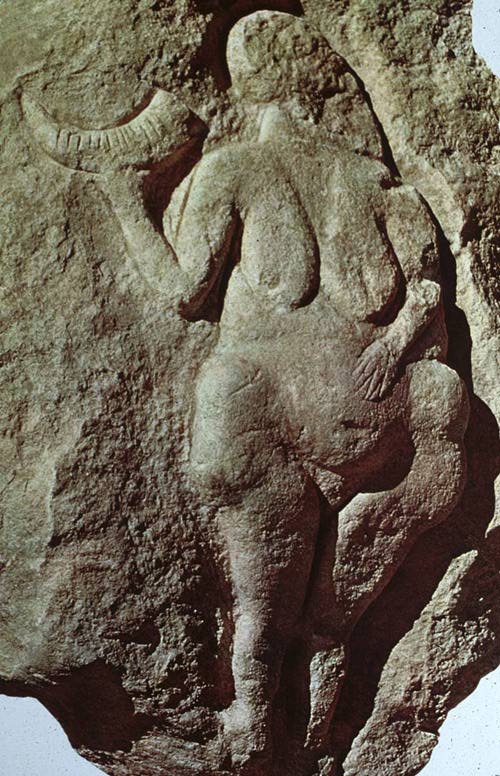
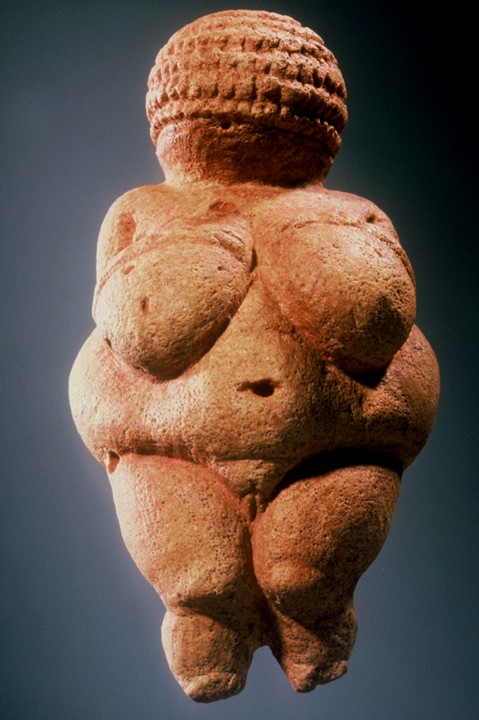
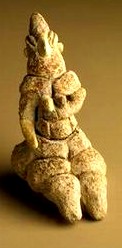
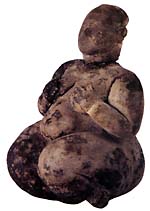
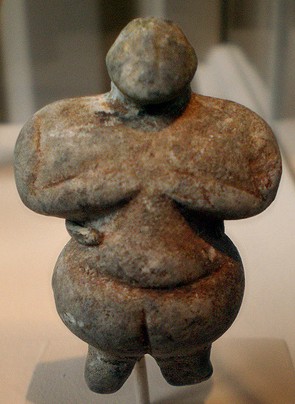
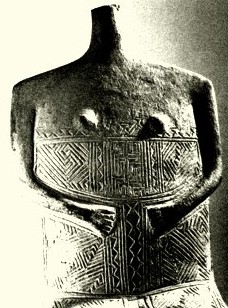
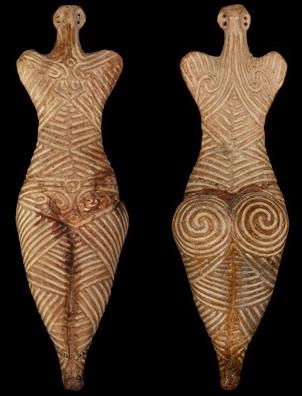
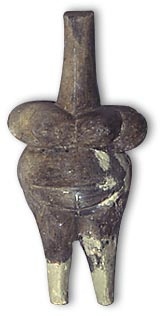
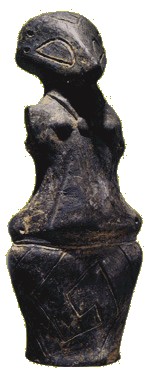
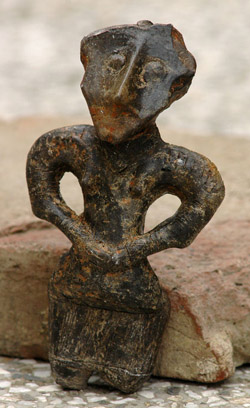
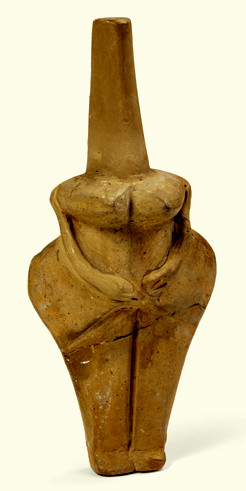
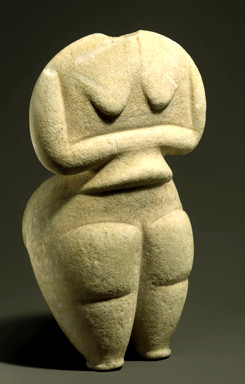
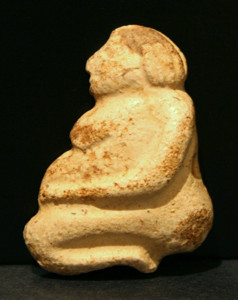
As you can see, these common mother images are simple, they are not wearing crowns or with any other imagery that becomes common with the religions shown after the times of the Proto-Indo-European waves, with their establishment of temples and priests. These mother images cover a wide range from Old Europe, through the Aegean Sea area, Ancient Anatolia, down the Jordan Valley and across, down the Tigris/Euphrates area of Mesopotamia. These territories are not the only ones that have these basic images, but they are the territories that I am dealing with in this study. Whenever a culture evidences the change from the previous native to that of the Proto-Indo-European dominated cultures, these mother images disappear.
In dealing with these older cultures, anthropologists have speculated, based on some modern native cultures that were similar, that there was not an understanding that the male had a role in procreation, which has a bearing on how the culture is organized. “ ‘James Frazer, Margaret Mead and other anthropologists,’ writes Leonard Cottrell, ‘have established that in the very early stages of man’s development, before the secret of human fecundity was understood, before coitus was associated with childbirth, the female was revered as the giver of life. Only women could produce their own kind, and man’s part in this process was not as yet recognized.’
According to these authors, as well as many authorities who have written on this subject, in the most ancient human societies people probably did not yet possess the conscious understanding of the relationship of sex to reproduction. Thus the concepts of paternity and fatherhood would not yet have been understood. Though probably accompanied by various mythical explanations, babies were simply born of women.
If this is the case, then the mother would have been seen as the singular parent of her family, the one producer of the next generation. For this reason it would be natural for children to take the name of their mother’s tribe or clan. Accounts of descent in the family would be kept through the female line, going from mother to daughter, rather than from father to son, as is the custom practiced in patriarchal societies, even today. Such a structure is generally referred to as matrilineal, that is, based upon the mother-kinship. In such cultures (known among many ‘primitive’ peoples even today, as well as in historically attested societies at the time of classical Greece) not only are names, but titles, possessions and territorial rights are passed along through the female line, so that they may be retained within the family clan.” When God Was a Woman, pg. 11,12.
“The role of the father in prehistoric antiquity was either not fully understood or not as highly valued as that of the mother. The female body gives evidence of maternity, while the male body does not give evidence of paternity. Further, in many societies females did not mate for life with their male sexual partners. This would lead to an inability to establish paternity, the identity of the exact biological father of a woman’s child. Establishing paternity is one of the cornerstones of the later patriarchal cultures, which insisted on controlling women’s reproductive behavior. This inability to establish paternity has an effect on social structure because, when the biological father cannot be determined, the mother and her kin automatically are the focus of the family, and the family structure is matrilinear.” The living Goddesses, pg. 112.
At this point, we need to define three terms that some mistakenly use synonymously: matrilinear, matrilocal and matriarchy. Matrilinear means the ancestry line follows the mater – mother, generally from mother to daughter, which includes inheritance. Matrilocal means that the marriages reside within the mothers kin group or clan, so for the sons to marry, they would leave their mother and be united to their wife’s family. Matriarchy means that the governing is by the mother, as opposed to a patriarchy, where the governing is by the father. You can have a culture that is matrilinear and/or matrilocal, without it being matriarchal. “The case against the universality of prehistoric matriarchy seems quite clearly proven by anthropological evidence. Yet the debate over matriarchy rages on, largely because advocates of the matriarchy as a society where women dominate over men, a sort of inversion of patriarchy, cannot cite anthropological, ethnological, or historical evidence. They rest their case on evidence from myth and religion. Others call matriarchy any kind of societal arrangement in which women hold power over any aspect of public life. Still others include any society in which women have relatively high status. The last definition is so vague as to be meaningless as a category. I think we can truly speak of matriarchy only when women hold power over men, not alongside them, when that power includes the public domain and foreign relations and when women make essential decisions not only for their kinfolk but for the community. In line with my earlier discussion, such power would have to include the power to define the values and explanatory systems of the society and the power to define and control the sexual behavior of men. It may be noted that I am defining matriarchy as the mirror image of patriarchy. Using that definition, I would conclude that no matriarchal society has ever existed.” The Creation of Patriarchy, pg. 31. For all the purposes of this study, my definition of matriarchy is the same as that of Lerner’s above.
An example of the origin of the maternal line is in historical accounts of Herodotus. “An Ionian Greek had only to travel down his own coast as far as Lycia to find men reckoning descent through the mother, or to travel back in imagination to the legendary origins of his own people, to find that their pedigrees went often up, not to a god, but to a woman. Olympian society was the same. The consort of Zeus held a very different position from that of the wife in a patriarchal household; and on the Asiatic shore, at least, the gods themselves were traced back to a Mother, not a Father, of them all.” Anthropology and the Classics, pg. 153.
There are diverse elements in the bible that point to two different systems, one which has the elements of the mother culture with an equalitarian government – a system where the competent, wise elder ruled, regardless of whether they were a male or female. The other system is the very clear patriarchal Indo-European based system of Father Sky gods, patrilinear lineages, inheritance, and the subjugation of women.
This brings me to the next point, that of creation. In nature, children are born from the woman’s body, but there are patriarchal Proto-Indo-European accounts of creation where the chief male deity takes over the accounts of creation, creating the male first and then the woman. These PIE accounts even have the male gods trying to give birth themselves, such as Zeus giving birth to Athene from his head. In the oldest accounts of creations, later associated with goddesses whose names are variants of mother and grandmother, the creatress (for lack of better words in an Indo-European language that stresses gender) creates pairs of humans from earth, clay, etc, not one gender then another.
While these agriculture cultures were clearly matrilinear and possibly matrilocal as well, there is no evidence that they were matriarchal. The same men that referred to the venus and goddess statues, also blanketly, without evidence referred to the government as being matriarchal, as opposed to patriarchal, but there are other systems of government. It is not an “either, or” option. It is not black or white. Many Native American cultures that are matrilinear and matrilocal have equalitarian rule (both genders jointly). The abundance of these female statues could simply be a representation of the natural life, mother, birth aspect of their society, without them being goddesses or priestesses of a goddess. Unfortunately, there are some women (some of them feminists) frustrated with women being oppressed by thousands of years of patriarchal religion, that have latched on to these figurines and created a whole other religion, where none may exist, as far as a goddess is concerned. These women are part of what is known as the goddess movement. In my eyes, they are just as irresponsible as the men that called these figures goddesses and speculated a matriarchy and priestesses, with no evidence. There are figurines of men in these “mother” cultures, just not as numerous and the males never are exhibiting warfare or domination, no thunderbolt or mace wielding gods. At least, not until the PIE invasion waves.
“In Neolithic Europe and Asia Minor (ancient Anatolia) – in the era between 7000 B.C. and 3000 B.C. – religion focused on the wheel of life and its cyclical turning. This is the geographic sphere and the time frame I refer to as Old Europe. In Old Europe, the focus of religion encompassed birth, nurturing, growth, death, and regeneration, as well as crop cultivation and the raising of animals. The people of this era pondered untamed natural forces, as well as wild plant and animal cycles, and they worshipped goddesses, or a goddess, in many forms.” The Living Goddesses, pg. 3. “We know that art, particularly religious or mythical art, reflects not only peoples’ attitudes but also their particular form of culture and social organization. The Goddess-centered art we have been examining, with striking absence of images of male domination or warfare, seems to have reflected a social order in which women, first as heads of clans and priestesses and later on in the important roles, played a central part, and in which both men and women worked together in equal partnership for the common good. If there was here no glorification of wrathful male deities or rulers carrying thunderbolts or arms, or of great conquerors dragging abject slaves about in chains, it is not unreasonable to infer it was because there were no counterparts for those images in real life.” The Chalice and the Blade, pg. 20. While this quote is truthful about the lack of warfare in these cultures art, prior to the patriarchal Proto-Indo-European invasions, there is no basis to assume goddesses and priestesses, nor to refer to it as goddess centered art; this art was the art of an agriculture, family oriented society.
“Our cultural programming also leads to the assumption that female representations invariably represent ‘earth as fertility’; therefore all naked female artifacts become ‘fertility figurines’. The Old European cultures certainly cared about fertility. But, as we will see, the wide variety of figurines, and particularly their Neolithic art forms played a wider religious role…In religious art, the human body symbolizes myriad functions beyond the sexual, especially the procreative, nurturing, and life enhancing. I believe that in earlier times, obscenity as a concept surrounding either the male or female body did not exist. Renditions of the body expressed other functions, specifically the nourishing and procreative aspects of the female body and the life-stimulating qualities of the male body. The female force, as the pregnant vegetation goddess, intimately embodied the earth’s fertility. But the sophisticated, complex art surrounding the Neolithic goddess is a shifting kaleidoscope of meaning; she personified every phase of life, death, and regeneration. She was the Creator from whom all life – human, plant, and animal – arose, and to whom everything returned. Her role extended far beyond eroticism.” The Living Goddesses, pg. 5. “For here we have a rich technologically and culturally advanced civilization in which, as archaeologists Hans-Gunther Buchholtz and Vassos Karageorghis write, ‘all the artistic media – in fact, life in its totality as well as death – were deeply entrenched in an all-pervasive, ubiquitous religion.’ But in marked contrast to other high civilizations of the time, this religion – centering on the worship of the Goddess – seems to have both reflected and reinforced a social order in which, to quote Nicolas Platon, ‘the fear of death was almost obliterated by the ubiquitous joy of living.’ “ The Chalice and the Blade, pg. 32.
This aspect of birth and life is very evident in the art of these non-Indo-European, non-patriarchal cultures. Besides nature being evident in the artwork, there is something else that is evident – no warfare, heroes, torture and afterlife. “Even when there is a written as well as an oral literary tradition, art is a form of symbolic communication. The extensive art of the Neolithic – be it wall paintings about daily life or about important myths, statuary of religious images, friezes depicting rituals, or simply vase decorations, pictures on seals, or engravings on jewelry – tells us a great deal about how these people lived and died. It also tells us a great deal about how they thought, for in a very real sense Neolithic art is a kind of language or shorthand symbolically expressing how people in that time experienced, and in turn shaped, what we call reality. And if we let this language speak for itself, without projecting on it prevailing models of reality, it tells us a fascinating – and in comparison to the stereotype, a far more hopeful – story of our cultural origins.
One of the most striking things about Neolithic art is what it does not depict. For what a people do not depict in their art can tell us as much about them as what they do. In sharp contrast to later art, a theme notable for its absence from Neolithic art is imagery idealizing armed might, cruelty, and violence-based power. There are no images of ‘noble warriors’ or scenes of battles. Nor are there any signs of ‘heroic conquerors’ dragging captives around in chains or other evidences of slavery.
Also in sharp contrast to the remains of even their earliest and most primitive male-dominant invaders, what is notable in these Neolithic Goddess-worshipping societies is the absence of lavish ‘chieftain’ burials. And in marked contrast to later male-dominated civilizations like that of Egypt, there is here no sign of might rulers who take with them into the afterlife less powerful humans sacrificed at their death. Nor do we find, again in contrast to later dominator societies, large caches of weapons or any other sign of the intensive application of material technology and natural resources to arms.” The Chalice and the Blade, pgs. 17, 18. “Gimbutas describes the weapons engraved in stone, stelae and rocks in Old Europe, after the Kurgan invasions, “ ‘the earliest known visual images of the Indo-European warrior gods.’ ‘Weapons obviously represented the god’s functions and powers,’ writes Gimbutas, ‘and were worshipped as representations of the god himself. The sacredness of the weapon is well evidenced in all Indo-European religions. From Herodotus we know the Scythians made sacrifices to their sacred dagger, Akenakes. No previous engravings or images of weapon carrying divinities are known in the Neolithic Alpine region.’ “ Chalice and the Blade, pg. 49.
“At the core of the invaders’ system was the placing of higher value on the power that takes, rather than gives, life. This was the power symbolized by the ‘masculine’ Blade, which early Kurgan cave engravings show these Indo-European invaders literally worshipped. For in their dominator society, ruled by gods – and men – of war, this was the supreme power…’The old European and Kurgan cultures were the antithesis of one another. The Old European were sedentary horticulturalists prone to live in large well-planned townships. The absence of fortifications and weapons attests the peaceful coexistence of this egalitarian civilization that was probably matrilinear and matrilocal. The Kurgan system was composed of patrilinear, socially stratified, herding units which lived in small villages or seasonal settlements while grazing their animals over vast areas. One economy is based on farming, the other on stock breeding and grazing, produced two contrasting ideologies. The Old European belief system focused on the agricultural cycle of birth, death, and regeneration, embodied in the feminine principle, a Mother Creatrix. The Kurgan ideology, as known from comparative Indo-European mythology, exalted virile, heroic warrior gods of the shining and thunderous sky. Weapons are nonexistent in Old European imagery; whereas the dagger and battle-axe are dominant symbols of the Kurgans, who like all historically known Indo-Europeans, glorified the lethal power of the sharp blade.’ “ The Chalice and the Blade, pg.48.
These mothers represent life. They produce life from their bodies, in a flood of birth water (amniotic), which is later carried into the myths of the mother goddesses, the creatresses. These mothers were not just of humans, but animal mothers as well, which later came to be an artistic expression of first the mothers, then mothers with animals around her, including plant life. Nature was surrounding her. “In 1962 James Mellaart described the cultures of 9000 to 7000 BC in his ‘Earliest Civilizations of the Near East’. As I mentioned previously, he pointed out that at that time, ‘Art makes its appearance in the form of animal carvings, statuettes of the supreme deity, the Mother Goddess.’ “ When God Was a Woman, pg. 24. Eventually, the tree came to represent the mother and the female figure was removed from some of the images, especially after the PIE incursions with the male dominance.
So here we see mothers of families and mothers of clans, who are probably leading or co-leading in an equalitarian society with the men or elders. Is this equality of the genders a vilified concept as the patriarchal Indo-Europeans would have you to believe? No. Are there examples of this equality in the Tanak? Yes. Let us look to the first woman, Chawwah [the female form of the Hebrew word life – chay, Eve], who was given dominion with her husband. Hawah also means tent, village in Hebrew, the multiplying and assembling of life. Bereshiyth [Genesis] 3:20, “and the man called the name of his ishshah [wife] chawwah, for she became the mother of all life [chay].” This is the common epitaph of all the central mothers that ended up being made into goddesses – the mother of all life. Later you see the patriarchal re-mything of this account and in comes the serpents/dragons, the swords, the expulsion and debasing of the mother, no more equality.
Now let us take a look at a woman who led the Israel confederacy as a chief. In the book of Shoftiym [Judges] , chapters 4 and 5, we see the account of Deborah, the wife of Lapiydoth. She is listed as being a prophetess and was judging Yisrael at that time. Before we go any further, we need to define some names and Hebrew words, otherwise you will not see the truth of this account. Deborah [DBWRH] is defined in the Hebrew as meaning bee. It is related to the word dabar [DBR] which means to speak, declare. Supposedly the association with the bee is from the humming sound like that of speaking. But there is a far better association with the bee, and that is a common motif in these ancient mother cultures, the bee as queen of a hive. The H on the end of the name shows that it is female. Now look at the fact that they say that Deborah is a prophetess. What do prophetesses do? They declare, speak, which is the same word as dabar [DBR]. Whether or not her name was actually Deborah or it was a title, she has an association with bees and prophecy, the same as the early mother cultures and the same as the merging of the women that were eventually portrayed as goddesses and priestesses.
Next we need to look at her leading Yisrael. The Hebrew word that is now commonly translated as judge, shofet, is originally used for chiefs. When the priestly system overthrew the tribal system of chiefs and elders, the chief term became judge, a function of the priesthood. Deborah is a chief over the confederacy of Yisrael. She ruled under a palm tree, yet another symbol of these mothers to become goddesses. She calls forth a man named Barak and instructs him, according to a word of YHWH, to gather the militia forces of some of the tribes to assemble for war against Siysera, a commander of an army under Yabiyn, who has iron chariots and a huge army. What does Yabiyn sound like with his iron chariots and massive army? A Proto-Indo-European invading force. Deborah is not acting as a judge, she is acting as a chief and prophetess. She even goes out to war and directs the campaign against this army. After the victory, Deborah and Barak sing to YHWH. Chapter 5:7-8, “the ferazun ceased in yisrael; they ceased until i, deborah, arose; i arose as a mother in yisrael. 8 they chose new elohiym; then war was at the gates. neither a shield nor a spear was seen among forty thousand in yisrael.” This passage states a number of principles, Deborah is a mother in Yisrael. They are a people of peace with not a shield or sword between 40,000 men. This is a common description of the non-PIE, mother cultures.
Ferazun is from the Hebrew root feraz, which mean open, unwalled. Another description of the mother cultures who did not build walled cities as the PIE cultures did. Ferazun are the leaders, chiefs of these unwalled rural cities. These Ferazun had ceased until Deborah rose up again. The Ferazun leaders ceased because they chose new gods, then war was at the gates. This sounds like the war gods of the PIE culture who either assimilated or destroyed the cities they chose to take. Verse 11, “louder than the voice of the dividers between the watering places there, they will tell of the righteous acts of YHWH, the righteous acts of his ferazun in yisrael. then the people of YHWH went down to the gates.” Here we see that the Ferazun are associated with righteousness and with YHWH. This account, with all its symbolism and linguistics, shouts about these peaceful mother oriented, equalitarian cultures that were attacked by Proto-Indo-European invaders. And without gender bias or patriarchal assimilation, one of these shoftiym, ferazun, prophetesses was a woman and a mother of Yisrael.
Now here is the big question. Since these mother cultures do not have altars and temples, no evidence of sacrifices and such, did these later cultures actually worship the mother, clan mother, etc as a goddess, or was the aspect of a goddess, and the associated worship created by the PIE patriarchal religion as a means to acquiesce to the natives since they could not totally eradicate the maternal culture? Did the PIE religious system of animal and human sacrifices create the sacrifices that are mentioned in this passage of YirmeYahu? Clearly, these people had a previous lifestyle that was followed throughout that territory. At that time, in their beliefs of this exalted mother and nature system that she represents, they had plenty of food to eat, were well and saw no evil, but after they stop living this lifestyle and are forced into the patriarchal PIE priesthood system of taxation and slavery, they lack all things and are devoured by the sword, the warfare endemic of the patriarchal PIE culture.
This is very similar to the wise women who used herbs to take care of health, treat illnesses and midwife, that were later vilified by the Catholic church in the Middle Ages, just for using plants, as being witches. For hundreds of years in Europe, women were massacred in villages, hunted down, tortured and their whole maternal lines killed, because everyone knows that witches pass this on to their other female family members, not to mention their belief that all the female friends of such a woman were also suspect and killed. Medicine fell into the dark ages due to the Catholic churches association of herbs with witchcraft. If the PIE patriarchal priests were stopping the agriculture practices of the people, that they felt had any association with the earth, clan, creator mother, however you want to label it, that would seriously curtail the agricultural prosperity that all these cultures had known.
In the following section of Ancestor Worship, you will see how a leader, with stories of his heroic accounts, became a legend and eventually a god in the patriarchal Proto-Indo-European cultures. This aspect of legends and deification has always been a part of men’s history. Whether you are looking at a god, in the sense of a deity in the heavens or in the glorification of a man, such as George Washington to the American patriots, it still occurs. Many Tall Tales, the product of American legends, had men that stood out and became larger than life in each retelling of the accounts. Our more current culture does not have kings who became gods when they died, but we had a great lumberjack who took on the character of a giant and then had to have a mount to fit his tall stature and was given Babe the Blue Ox. This is the exact same process that created goddesses and gods from leaders, heroes, people who were extraordinary in some capacity. A wise and capable mother becomes a head of her clan, to the point that when she dies, she is still held in great esteem, her wisdom is passed on and each time she is spoken of to future generations, the faults are generally forgotten and the attributes are exalted. The work of her hands are associated with creation, her wise words become those of a goddesses, she is now the mother of not only her direct family, but of all those succeeding generations – all living.
The following are a few examples of non-PIE cultures mother “goddesses” that were taken over by a PIE culture and remythed into a patriarchal religious system.
Hattian – Estan, the mother goddess of Hatti, prior to the Hittites, later became the Goddess of Arinna (Spring fed pool), known as the Sun Goddess of Arinna, a major Hattian city close to Hattusas, which became the Hittite capitol. She is the Mother goddess before the PIE Hittites subjugated them and diminished the mother in their mythology. She is related to the pre-Hurrian HannaHannah and Khebat. She is called the Mistress of the Hatti lands, Queen of heaven and earth and of all countries. “The mother goddesses were responsible for the creation of humanity and for birth in general, while the goddesses of fate determined human destiny.” Anatolia section of Religions of the Ancient World, pg. 404. The Hittites later change her to a male and the deity name is then Istanu, the male sun god.
“The deities assimilated by the Hittites from the indigenous Hattians are somewhat unclear to modern scholars because of our still scant knowledge of the Hattic language. The Hattian pantheon seems to have been at first a collection of personifications of aspects of nature, such as Estan (‘Sun’ or ‘Day’) and Kasku (‘Moon’), and expressions of life forces represented by mother goddesses (Kattahha; Hannahannah, meaning ‘Grandmother’; Kubaba; and Wurusemu), king-war gods (Wurrunkatte, Zababa, and Kattishabi), and a storm-weather god (Taru). Later deities derived in part from the Hurrians were, for the most part, more endowed with human characteristics, not always noble ones, than those of the Hattians and old Hittites, and were clearly influenced by Mesopotamian deities.” The Oxford Companion to World Mythology, David Adams Leeming, pg. 187.
Pre-Hurrian – Khepat (Khebat, Hepatu, Hebat, Kheba, Khubaba [later associated with Kybele]), is called the mother of all living. Another name for the pre-Hurrian mother was HannaHannah (HannaHannas) is the divine ancestress and holy grandmother of the territory that came to be associated with the later Hurrians, who assimilated part of that culture as they left the Caucasus Mountains and moved south. Hannahannah’s special animal is the bee, symbol of hearth and home. The PIE word for grandmother is haen. The following are other Proto-Indo-European languages, that derived from the original PIE, for grandmother. Old High German is ana, Old Prussian is ane (female ancestor), Hittite is hannas, Greek annis, Old Irish ana (mother of the gods), Luvian anna, Lydian ena. You can clearly see that this name is from the PIE stock, but since there is no written, alphabetic name for this grandmother, mother “goddess” of the pre-Hurrians, we are left with what the invaders called her. The Hurrians exhibit elements of the original culture. HannaHannah has associations with the bee, as do many of the ancient Anatolian and Aegean variations. Hannahannah and the Sun Goddess of Arinna are both from the 2500 BCE time period. Another association is with the later Canaanite Anath and the Aegean, western Anatolian Athene / Athena.
Sumerian - Inanna is a mother goddess, and is the granddaughter of the Sumerian Creatress goddess Nammu, who created the gods and mankind. Nammu was known as ‘She who gives birth to heaven and earth,’ as well as ‘the mother of all deities. “The Sumerian prima materia (prime/first matter) was personified in the form of a deity as were all other elements of nature. The Sumerian list of deities gives this honor to the goddess Nammu ‘written with the pictograph for primeval “sea,” described [as] “the mother, who gave birth to heaven and earth” (Kramer 1959, p. 83). The other texts call her ‘mother, first one, who gave birth to the gods of the universe’ or as ‘Mother of Everything’ (Leick 1994, p. 13). The Sumerian sign used to describe he is ENGUR. The same sign was used as a synonym of abzu (apsu) which can be translated as ‘the sweet water sea/ ocean’ and ‘the watery deep,’ strongly suggesting the subterranean ocean.” Creation Stories of the Middle East, pgs. 45, 46.
The Mes were Tablets of Destiny (Civilization) which were worn around the neck of the Creatress. In one account the Mes are given by Enlil to Enki, who was a son of Nammu. Enki is later listed as Marduk’s father. Later accounts clearly show that when the mother was killed by the warrior king/son, the usurper took the tablets to rule with. Yet the older system was matrilineal and the Mes would have passed to the daughters. This killing of Nammu (Sumerian) / Tiamat (Akkadian) is later achieved by Enki’s son, Marduk, who takes the Mes from her body. “Nevertheless, the author succeeded in his goal – Marduk elevated to the role of the leading god. In order to do so, he had to ‘kill’ the female principle, Tiamat, the mother of all, personification of the salt waters.” Tiamat, is a variation of the word tiamutum, which means the sea. In the third century BCE, Berossos, a priest of Bel (Marduk) wrote Babyloniaka, a presentation of the history and culture of Babylonia from creation to his time, based on the earlier myths. Dealing with creation, Berossos refers to the chaos of the darkness and water. This darkness and water was Omorka / Um-ruk - Babylonian / Tiamat - Akkadian / Thalath – Ancient Greek / Thallata - Greek. Nammu who represented the water and order, assimilated and changed by the Akkadian invaders to Tiamat, now represents the waters of chaos, needing, according to the PIE beliefs, a man to bring order to the primordial chaos. This life giving water would later be replaced by the rain of the storm gods – their semen/seed, so to speak.
In the Sumerian accounts, Inanna asks for the Mes and is denied so she gets her father drunk and he then gives her the Mes, which she takes back to her city of Uruk. This may be a representation of Inanna trying to reclaim what was originally the work and teachings of the mother culture that the patriarchal invaders took and claimed as their labors and inventions. Inanna was associated with the earth, grain groves, wine and love. In the older accounts, Inanna prefers to wed Enkidu a farmer god, but Dumuzi, obviously a Kurgan / Indo-European shepherd deity takes her for his wife. The PIE culture not only kills the revered mother, but forcibly takes the granddaughter for a wife to legitimize their rule. One of the other Sumerian names for Inanna is Iahu, which means, “Exalted Dove”. It is in this form that the legend of Marduk cutting Tiamat in half, in the form of a dove, is represented. This was understood at a Babylonian spring festival when they cut a dove in half, representing Marduk cutting Tiamat in half and establishing his governmental order. Inanna, also spelled Ninanna, Innina and Irnina is also related to the Hattian Arinna mother goddess before the Indo-European Hittites subjugated them and diminished the goddess in their mythology. She is also related to the Hurrian HannaHannah mother goddess of that native culture that the Indo-European Hurrians conquered and assimilated. Later, another PIE culture assimilates Inanna with a later goddess named Ishtar.
An interesting note to the Sumerian are the reforms of Urukagina, from about 2300 BCE, after PIE invasions. It showed that the culture was previously communal. They speak of fruit trees and food from temple lands that were for the feeding of those in need, which the later PIE priests were taking. The tablets mentioning these reforms speak of the ways that things were done in an earlier time, using the reform word amargi, which means freedom and return to the mother.
Aegean and Western Anatolian - Athene / Athena is a shortened Anglicized version of this woman’s PIE name, a title actually, Athana Potnija, which means Mistress / Lady of Athana, later coming to be associated with the creation of Athens, but this title occurs on Late Mycenaean (a PIE culture that invaded Crete and the Minoans) inscriptions at Knossos, prior to the establishment of Athens as it came to be known. Athana was part of the Minoan culture, which had ties to the western Anatolian culture, prior to these PIE invasions. The character of Athene is very complex and is a very strong bridge between the original mother cultures and the later invading Indo-European cultures. As a result, I am going to have to cover in detail, this personification of the mother, so that you can see all the original elements and how they came to be applied in the Tanak/Bible.
Athene preceded the Olympian pantheon and since they could not wipe her out, they re-mythed her to be born from Zeus’ head and made her his daughter, removing the spindle from her hand and replacing it with a spear. The re-mything of her city, Athens, associated with a sacred fresh water spring at the Athenian Acropolis, is very much like the accounts of the sacred spring at Arinna, increasing the connection with the goddess of Arinna. “In her central function, as in the extent and profundity of her worship, Athena shows marked similarities to an earlier guardian deity, one we have come to know only in recent years, the great Anatolian war-goddess of the second millennium BC, the protectress and champion of the Hittite kings, the widely and intensely revered Sungoddess of Arinna. (note 4 – the Hittite deity also shares Athena’s association with craft: her holy city of Arinna was a centre of metalworking.).” Athena in the Classical World, pg. 349. Linguistic evidence points to the borrowing from the Hattian Arinna, through the Luwian (PIE) Adana to the Mycenaean (PIE) Athana. “It is, finally, of some considerable interest to note that Homer’s Trojans, who quite likely spoke Luwian outside Greek epic, address Athena with a typically Anatolian title: Potni’ Athenaie, using (in Greek) a morphological form shared with – and prominent in Hittite (the adjectival suffix - iya) and a syntactic feature of Luwian syntax being the use of adjectives (in –assa in Luwian) to replace genitive in indicating the relationship of one noun to another.” Athena in the Classical World, pgs. 364, 365. Athene (Hellenes – Classical) = Atana (Mycenaean in Minoan) = astanus (Luwian in Anatolia - sun) = Estan (Hattian in Anatolia).
Another example of the origins of Athene in the Anatolian territory is the story of her birth. In the later Greek account, Athene, the prior earth mother that could not be wiped out, is born from the head of Zeus. Zeus’ first wife was Metis, a Titaness. There was a prophecy that a child from Metis would be greater than the father. Zeus, trying to avoid an overthrow by his offspring, as he had done with his father Kronos and he had with his father Ouranos, decides not to swallow the offspring, as his father had done, but to swallow the pregnant mother Metis, after tricking her to change herself into a fly first. After having severe migraines, he tells Hephaestus to crack open his head and Athene, fully dressed and in armor and a spear, leaps out of his head. In much older Hittite accounts, Kumarbi, the son of Anu, the god of heaven, tries to overthrow his father. When Anu tried to escape, Kumarbi bit off and swallowed the genitals of his father. When he discovered that this had impregnated him, he spat out the semen, but the pregnancy of Teshub, his son, remained and had to be cut out of him. Another account has another deity, Kazal, emerging from his skull. Another example of a PIE’s culture trying to take on the mother roles of childbirth.
To make matters even more clear, in the city of Wilusa (later known as Troy, Hatti territory), on the western portion of Anatolia, the patron deity of the city and the major temple there was Athene. If you look at the symbolism on Archaic Greek pottery associated with Athene and those of Troy archaeology, especially spindle whorls, it is the same. The legend was that the city could not be taken, so long as the image, palladium, of Athene remained in the city. Apollodorus [3.12.3], “But Ilus went to Phrygia, and finding games held there by the king, he was victorious in wrestling. As a prize he received fifty youths and as many maidens, and the king, in obedience to an oracle, gave him also a dappled cow and bade him found a city wherever the animal should lie down; so he followed the cow. And when she was come to what was called the hill of the Phrygian Ate, she lay down; there Ilus built a city and called it Ilium (Troy). And having prayed to Zeus that a sign might be shown to him, he beheld by day the Palladium, fallen from heaven, lying before his tent. It was three cubits in height, its feet joined together; in its right hand it held a spear aloft, and in the other hand a distaff and spindle.”
Pausanias, Description of Greece 9. 12. 2 : "[The mythical founder of Thebes] Kadmos and the host with him were to make their dwelling [found Thebes] where the cow was going to sink down in weariness. So this is one of the places that they [the Thebans] point out. Here there is in the open an altar and an image of Athena, said to have been dedicated by Kadmos. Those who think that the Kadmos who came to the Theban land was an Aigyptian (Egyptian), and not a Phoinikian (Phoenician), have their opinion contradicted by the name of this Athena, because she is called by the Phoinikian name of Onga, and not by the Aigyptian name of Sais."
In later Ugarit culture, Athene is Anath, the warrior goddess daughter of the male god El. There are bilingual inscriptions from Cyprus (KAI 42) that have Athene in one language and Anat in the other.
For much more detailed information, please see Athene under the Aegean Sea / Phoenician / Felishthiym / Carthaginian subsection of the Deities section.
Transformation to Goddess and Consort
Concerning the patterns of assimilation by the Proto-Indo-European invaders, Lerner states, “…just as the development of plow agriculture, coinciding with increasing militarism, brought major changes in kinship and in gender relations, so did the development of strong kinships and of archaic states bring changes in religious beliefs and symbols. The observable pattern is: first, the demotion of the Mother Goddess figure and the ascendance and later dominance of her male consort/son; then his merging with a storm-god into a male Creator-God, who heads the pantheon of gods and goddesses. Wherever such changes occur, the power of creation and of fertility is transferred from the Goddess to the God.” The Creation of Patriarchy, pg. 145. “It is quite ironic that, chronologically speaking, the perception of the origin of the universe has gone through transition from the female element as the only mover (Nammu), then to male and female as a couple (Tiamat and Apsu), and finally to the presence of the only mover – a male (Marduk).” Creation Stories of the Middle East, pg. 51. “Noah Kramer explains this change in the theogeny as the result of the increasing influence of priests, who are associated with particular temples and particular cities and their rulers. These priests now record the ancient myths in such a way as to serve political ends. Kramer notices the absence from the lists of Namu, the Mother-Goddess, formerly hailed as creator of the universe and mother of the gods. He thinks her powers were transferred to her son Enki ‘in an apparent attempt to justify this bit of priestly piracy’ “. The Creation of Patriarchy, pg. 153.
“In other instances, the Great Goddess herself became transformed. In the earlier period her attributes had been all-encompassing-her sexuality connected with birth, death, and rebirth; her power both for good and evil, for life and death; her aspects those of a mother, warrior, protector, and interceder with the dominant male god. In the later periods her various qualities were split off and embodied in separate goddesses. Her warrior aspect diminished, probably relegated to the male god, and her qualities as a healer were more and more stressed. This does appear to reflect a change in concepts of gender in the societies in which she was worshipped.” The Creation of Patriarchy, pg. 159.
So what began as a mother, a personification of the natural life, became, especially under the Proto-Indo-European religious systems, a goddess, at first assimilated into their pantheon, by forced marriages and rape as a wife or consort, then further demoted. Eventually her characteristics and abilities are parceled out to male deities and lower divided female deities, meaning where one goddess had been before, that two or more are created with specific attributes associated with each. For example in the Greek, the mother goddess was split into 4 distinct, yet in some older legends overlapping, goddesses: Demeter/Hera the mother, Athene the creator and patron of crafts and skills as well as protectress, Artemis the huntress and Aphrodite the seductress. An Egyptian example is the mother/creatress Au Set, who ends up becoming Isis. In the 3rd century BCE, as Ra becomes the dominant male deity, a female protectress goddess is created, named Bastet, originally named Ubesti. She is considered the Eye of Ra and is depicted as a lioness. Later, there are two eyes of Ra and Bastet is one, with her sister Sekhmet. Sekhmet becomes the blood thirsty warrior with the lions head, while Bastet is depicted as a domesticated cat and has more qualities of fertility. In some cultures, the goddess simply had her gender changed and the patriarchal conquest was complete. An example is that of the Hurrian Mother Estan being changed to the male Istanu. Through the patriarchal conquests the Mother with the clan/family government was killed and the Father with the king/priesthood ruled.
Proto-Indo-Europeans and the Patriarchy
Before I get into any quotes and information, I want to clarify something right up front, there are some writers, scholars and even archaeologists, when discussing the subject of the Proto-Indo-European culture, especially in light of the invasions on their neighbors, who frequently refer to the neighbors as Goddess cultures, Earth Mother worshippers, etc. There is absolutely no proof, not textually, not archaeologically, that these cultures which were matrilineal and agriculturally based, worshipped a goddess. This is explained further on in the Clan Mother to Goddess section, but I want to give you a heads up now, when you see these terms and phrases in the quotes, ignore it and read instead – matrilineal agricultural culture. This will all become clear very shortly.
Below is a map, showing the western portion of the Eurasian Steppe territory (modern day Ukraine and southwestern Russia). This territory, east of the Dnieper River, around the Sea of Azov and around the Caucasus Mountains that lie between the Black Sea and the Caspian Sea is the birth place of a culture that has come to be called Proto-Indo-European by some archaeologist, anthropologists and linguists. Some archaeologists also called these peoples by various characteristics, such as Kurgans, because of their distinctive kurgan burials or Yamna culture. Some had previously just referred to them as Aryans. Other archaeologists and anthropologists have referred to them by the modern day territorial term of Eurasian Steppe Dwellers or Pontic Steppe Dwellers. Regardless of what they are called, they have a very distinctive culture and religion, which will be explained below.
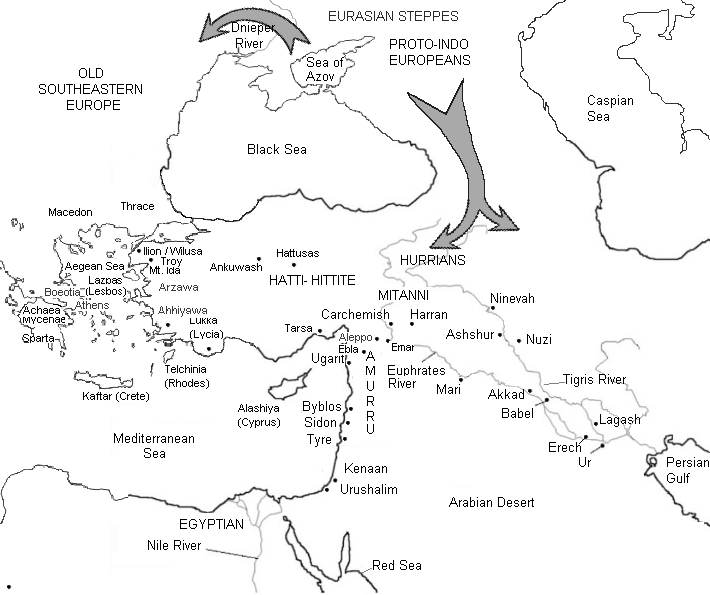
“In Old Europe the physical and cultural disruption of the Neolithic societies that worshipped the Goddess also seems to begin in the fifth millennium B.C.E., with what Gimbutas calls Kurgan Wave Number One. ‘Thanks to the growing number of radiocarbon dates, it is now possible to trace several migratory waves of steppe pastoralists or “Kurgan” people that swept across prehistoric Europe,’ reports Gimbutas. These repeated incursions and ensuing culture shocks and population shifts were concentrated in three major thrusts: Wave No. 1, at c. 4300-4200 B.C.E.; Wave No. 2, c. 3400-3200 B.C.E.; and Wave No. 3, c. 3000-2800 B.C.E. (dates are calibrated to dendrochronology).
The Kurgans were what scholars call Indo-European or Aryan language-speaking stock,… In fact, they were not the original Europeans, as they swarmed down on that continent from the Asiatic and European northeast. Nor were they even originally Indian, for there was another people, the Dravidians, who lived in India before the Aryan invaders conquered them.
But the term Indo-European has stuck. It characterizes a long line of invasions from the Asiatic and European north by nomadic peoples. Ruled by powerful priests and warriors, they brought with them their male gods of war and mountains. And as Aryans in India, Hittites and Mittani in the Fertile Crescent, Luwians in Anatolia, Kurgans in eastern Europe, Achaeans and later Dorians in Greece, they gradually imposed their ideologies and ways of life on the lands and peoples they conquered.” The Chalice and the Blade, pg. 44. “The brotherhood of Hades, Poseidon, and Zeus recalls that of the Vedic male trinity – Mitra, Varuna, and Indra – who appear in a Hittite treaty dated to about 1380 B.C. – but in this myth they seem to represent three successive Hellenic invasions, commonly known as Ionian, Aeolian, and Achaean. The pre-Hellenic worshippers of the Mother-goddess assimilated the Ionians, who became the children of Io; tamed the Aeolians; but were overwhelmed by the Achaeans.” The Greek Myths, pg. 43.
“Debates have long raged over the precise location of the homeland from which the Indo-Europeans dispersed (for a review of the controversy see Mallory 1973). Over the last two decades, consideration of archaeological evidence has been of prime importance in this debate, as various scholars have sought to match the remains of various peoples of prehistory to that is posited for Proto-Indo-European civilization on the strength of linguistic paleotology. Of the arguments which have been advanced, those which have won the broadest acceptance are those of Marija Gimbutas, who has identified what she calls the ‘Kurgan Culture,’ dating to the middle of the fifth millennium B.C., and located in the land north of the Black Sea, including such groups as the Jamna (also spelled Yamna) culture of the Ural-Volga area north of the Caspian, and the Srednij Stof II culture north of the Black Sea (see Gimbutas 1963, 1970, 1973, and 1974; Mallory 1976-77; Thomas 1982). Here, Gimbutas has located a culture area which very closely parallels the known features of P-I-E society, and she has also suggested that the dispersion of Indo-Europeans into Europe and Anatolia occurred in three great waves of invasions during the fourth and third millennia B. C., through which they overthrew the civilizations which had earlier flourished there (Gimbutas 1977, 1980).” Death, War and Sacrifice, Bruce Lincoln, pgs. 3,4.
One of the major characteristics of these Proto-Indo-Europeans is that they are patrilineal and patriarchal in nature. This means that they trace their descent, which is crucial to them, through the patri/pater – father and the form of government is rule by the patri/pater. There are no partnerships, no equalitarian rule, no council of elders. The father is the king, chief warrior and priest of their religion. The Proto-Indo-Europeans languages all stress gender, which is a crucial element to get their gender bias across. This brings us to another major characteristic, that of a warrior society with all the weaponry. The Proto-Indo-Europeans worshipped war and incorporated that into their daily living, which means that “might makes right”. These people were not family oriented, concerned for the welfare of the clan, the community. They were not major artists and craftsmen, nor were they agriculturalists, thinking ahead, saving, storing. They took from others, first tribes directly around them, then other cultures that surrounded them (think Star Trek Borg).
“The picture which emerges is one of a semi-settled pastoral people, whose wealth consisted of relatively large herds, including domesticated sheep, pigs, goats, and, most important of all, cattle. Horses were also highly important, especially when yoked to chariots and used in warfare, while cattle remained the normal draft animals for peaceful purposes, the source of most foods, and the measure of wealth. Some agriculture seems to have been practiced, although this was much less important and prestigious an activity than herding or war. The pursuit of warfare, especially the raiding of livestock from neighboring non-Indo-European peoples, was facilitated not only by use of chariots but also by an elaborate weaponry built on a single metal, most probably copper or bronze.
Such weaponry and martial mobility combined to give the Proto-Indo-Europeans military supremacy over most other peoples of prehistory. Their desire for ever larger herds and for more pastureland motivated war and raiding on even larger scales, and ultimately led to the expansion of the Indo-European peoples from the original P-I-E homeland, until Indo-Europeans possessed and ruled over most of the territory from Iceland to India. In Europe, only the Finno-Ugrian peoples (Finns, Lapps (actually they prefer Sami), Estonians, Hungarians) and the Basques were not subjected to Indo-European conquest, while in Asia, the great civilizations of the Ancient Near East- Sumerians, Babylonians, Assyrians, and others – were able to resist for the most part, although certain Indo-European groups, most notably the Mitanni and the Kassite’s, were able to establish successful empires for a time. “Death, War and Sacrifice, pgs. 2, 3.
The archaeological and genetic evidence shows that these “neighbors” were matrilineal in birth lines (further information in the Mother Creator section). There is no evidence that these agriculture, artist, craftsmen cultures ever had a matriarchy (mother ruled), but rather were equalitarian oriented. The agriculturalists did not build fortified villages and cities. They did not build temples. They did not build funeral tombs or have stelae depicting war victories. These people were primarily peaceful, raised livestock in small amounts, depicted nature in their artwork, were very knowledgeable about the plant life around them, had homes that were equal in structure (there are no homes that stand out as being the homes of those with high status). These agriculturalists had developed weaving, metallurgy, ceramics, etc. “ ‘Old Europeans never tried to live in inconvenient places such as high, steep hills, as did the later Indo-Europeans who built hill forts in inaccessible places and frequently surrounded their hill sites with cyclopean stone walls,’ reports Gimbutas. ‘Old European locations were chosen for their beautiful setting, good water and soil, and availability of animal pastures. Vinca, Butmir, Petresti, and Cucuteni settlement areas are remarkable for their excellent views of the environs, but not for their defensive value. The characteristic absence of fortifications and of thrusting weapons speaks for the peaceful character of most of these art-loving peoples.’ “ The Chalice and the Blade, pg. 13.
“Remarkably, archaeological surveys show a blank in the Balkan uplands after this: No permanent settlements can be dated in the Balkans between 3900 and 3300 BC. At Hotnitsa in north-central Bulgaria, the burned houses of the final Copper Age occupation contained human skeletons interpreted as massacred inhabitants. The final Copper Age destruction level at Yunatsite, west of Karanovo, contained forty-six human skeletons, also interpreted as a massacre. Balkan copper mines abruptly ceased production – copper-using cultures in central Europe and the Carpathians switched to Serbian ores about 4000 BC, at the beginning of the Bodrogkeresztur culture in Hungary. Metal objects now were made using new arsenical bronze alloys, and were of new types, including new weapons, importantly daggers. People probably still lived in the Balkans, but herds of sheep grazed on the abandoned tells.
In the lower Danube Valley, in contrast, there are many post-Gumelnita sites, but the people of the Cernavoda I culture that appeared after about 4000-3800 BC left only a few female figurines, no longer used copper spiral bracelets or Spondylus-shell ornaments, made relatively plain pottery in a limited number of shapes, did not live on tells, and depended as much on stockbreeding as on agriculture. Metallurgy, mining, and ceramic technology declined sharply in both volume and technical skill. Ceramics and metal objects changed markedly in style. ‘We are faced with the complete replacement of a culture,’ Ecgeni Chernykh, the foremost expert on Copper Age metallurgy, said. It was ‘a catastrophe of colossal scope…a complete cultural caesura,’ according to the Bulgarian archaeologist, Henrietta Todorova.” The Lost World of Old Europe, David Anthony, pg. 48.
Some archaeologists and anthropologists have speculated that the reason for mass abandonments of settlements was not due to a Proto-Indo-European culture invasion, but due to climate change, which can be proven through dendrochronology, to have been a wee bit hotter and drier than time periods before and after, but there is more to these major cultural changes than a whole culture just packing it up and moving. “Region-wide abandonments of large settlements have been documented archaeologically in other areas, notably in the North American southwest (1100-1400 AD) and in Late Classic Maya sites (700-900 AD) in Mesoamerica. In both regions the abandonments were associated with intense warfare. The kind of climate shift that struck the lower Danube valley about 4200-3800 BC would not have made tell settlements uninhabitable. But it might have intensified conflict and warfare.
Settlements of the Cernavoda I type appeared just after the abandonment of the tells in the lower Danube valley. They contain ceramics that exhibit a mixture of steppe technology and indigenous Danubian shapes, and are ascribed to a mixed population of steppe immigrants and people from the tells. It looks like the tell towns of Old Europe fell to warfare, and the immigrants from the steppes were involved-somehow. But the primary causes of the crisis could have included climate change and related agricultural failures, or soil erosion and environmental degradation accumulated from centuries of intensive farming, or internecine warfare over declining timber and copper resources, or some combination of all of those.” The Lost World of Old Europe, David Anthony, pg. 51.
“At the core of the invaders’ system was the placing of higher value on the power that takes, rather than gives, life. This was the power symbolized by the ‘masculine’ Blade, which early Kurgan cave engravings show these Indo-European invaders literally worshipped. For in their dominator society, ruled by gods – and men – of war, this was the supreme power…’The old European and Kurgan cultures were the antithesis of one another. The Old European were sedentary horticulturalists prone to live in large well-planned townships. The absence of fortifications and weapons attests the peaceful coexistence of this egalitarian civilization that was probably matrilinear (lineage follows mother’s line) and matrilocal (families lived at/in clan mother’s location) . The Kurgan system was composed of patrilinear, socially stratified, herding units which lived in small villages or seasonal settlements while grazing their animals over vast areas. One economy is based on farming, the other on stock breeding and grazing, produced two contrasting ideologies. The Old European belief system focused on the agricultural cycle of birth, death, and regeneration, embodied in the feminine principle, a Mother Creatrix. The Kurgan ideology, as known from comparative Indo-European mythology, exalted virile, heroic warrior gods of the shining and thunderous sky. Weapons are nonexistent in Old European imagery; whereas the dagger and battle-axe are dominant symbols of the Kurgans, who like all historically known Indo-Europeans, glorified the lethal power of the sharp blade.’ “ The Chalice and the Blade, pg.48.
“Explicit pictorial representations of the Bronze Age gods are extremely rare. While they appear to have existed in both male and female form, the former are less bound by the traditions of the previous era than the latter. Rather, the male gods appear to belong to a new era in which metal and the warrior played a dominant role. The attribution of terracotta figurines to the religious sphere as representations of gods or worshippers must rely on subtle nuances, whereas the religious character of monumental work such as the stelai and menhir statues particularly of southwest Europe and the entire Alpine region is beyond doubt.” “A thematic change implies cultural influences coming from the Balkans and extending progressively to the Alpine regions, France and Spain. Other phenomena taking place in this context include the spread of copper metallurgy, with weapon prototypes originating in eastern Europe, and the introduction of the earliest wheeled vehicles, ox-draen carts of similar origin. The Chalcolithic and Bronze Ages are marked by the emergence of religious veneration of weapons and metal objects, which are depicted with great frequency and possess special significance.” Gods and Heroes of the European Bronze Age, pgs. 133, 134, 143.
Below are several images of the weaponry exhibited on stelae and menhirs from a number of territories that began or became Proto-Indo-European cultures. 1. The Kernosovka Stele from the Ukraine territory, about 4500 BCE. 2. The Algund Menhir from Lagunda, Italy, 3500 BCE (line drawing next to photo – notice the chariot below the daggers, being drawn by two stick figure animals) . 3. Arco I Stele from Trento, Italy, 3000 BCE. 4. Solana de Cabanas, Iberia (Southern Spain), 1200 BCE.
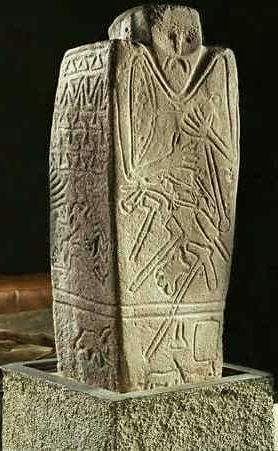
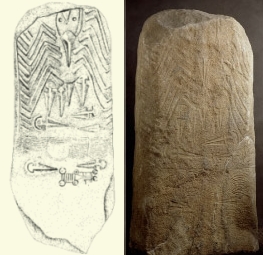
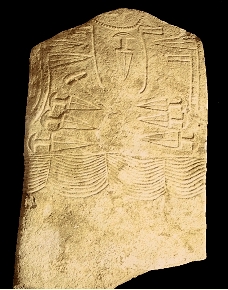
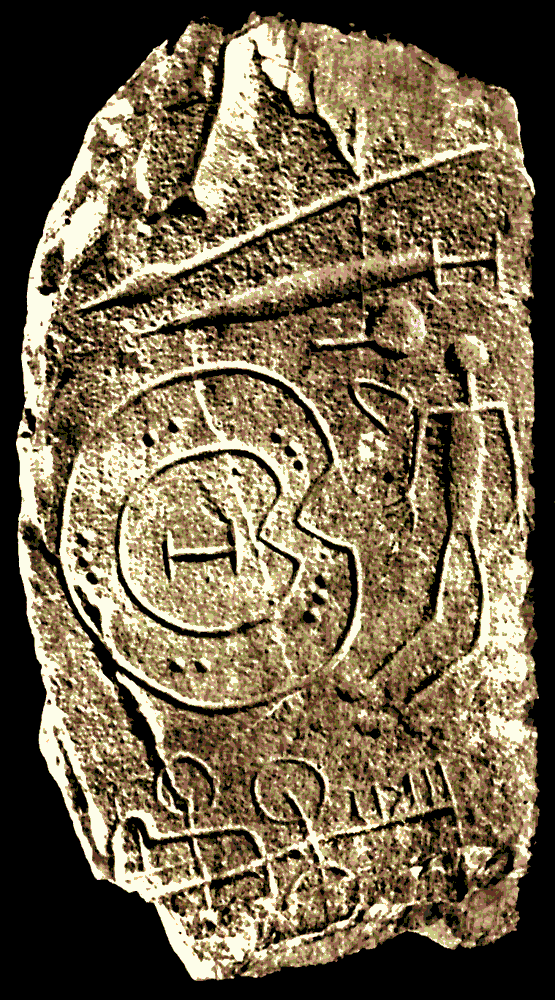
All of these stelae are similar in depicting the warrior chief/king with his weapons and chariots to those in the Mesopotamia and Anatolian areas that occur later, with much more detail and skill, depicting kings slaying enemies and prisoners: the Ur Standard 2600 BCE and the Naram Sin Victory Stele from Susa 2239 BCE.
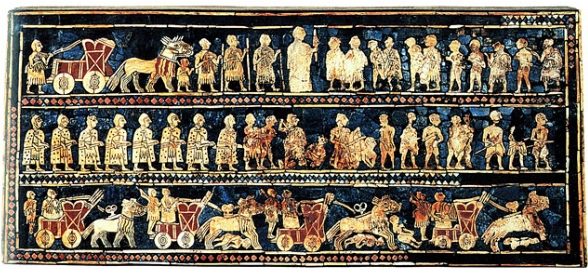
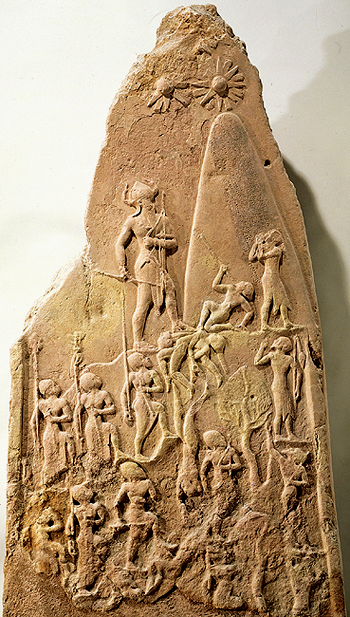
Then in different waves, from 4000 – 2500 BCE, you see archaeological evidence of sudden invasions and occupations of these agriculturalists by the Proto-Indo-European (PIE) cultures. Some of the villages are burned and rebuilt in the fashion of the PIE cultures, with walls, temples and larger structures for the elites. The women and children often are kept alive and used as slaves. “Linguistic evidence for the fact that women were enslaved prior to men is also suggestive: The Akkadian cuneiform sign for ‘female slave’ was ‘woman’ plus ‘mountain,’ which seems to indicate the foreign origin of female slaves. In fact, most of the slaves came from the eastern mountains, probably the area of Subarea. According to one authority, the sign for ‘slave woman’ appears earlier than that for ’male slave’. This would seem to speak for the fact that women, mostly foreign war captives, were enslaved before men.” The Creation of Patriarchy, Gerda Lerner, pg. 86. Burial tombs (kurgans) are then found and the weaponry that is so common to the PIE invaders is found in the tombs. Some of the villages show mass graves of the native men, with later generations showing that the genetics of the women were the natives and the men were the PIE invaders. Not all villages were burned and the men killed. Some of them were subjected to PIE rule and became servants. This is another characteristic of the Proto-Indo-Europeans, they have a tripartite caste system: King/Priest, Warriors and Servants/Workers, sometimes a 4 part system where the kings have become a inherited system, second priests, third warriors and finally the native workers . The servant/workers generally come from the native population that they have taken over. In each of these areas that the PIE culture encroached, there is always archaeological evidence for a technical decline, or dark ages following the invasion. After they take over an area, they create a monopoly on the metals necessary to produce their weaponry and wealth. Power to dominate and destroy replaces the aspect of nurturing and support of the community. The details of art then disappear for awhile, since these PIE warriors do not produce the art. Their art is war- raping, pillaging and conquering.
An example of this PIE culture, even within the Semitic language base, is that of the Akkadians, mentioned earlier. The Akkadians came and conquered the Sumerian culture to the south. Sargon, king of Akkad, invaded and assimilated the Sumerians in the 2nd millennium BCE. To justify his invading and establishing his kingship over the matrilineal Sumerians, an account of his birth, known as his Birth Legend, was written. Not all the lines of this account survive, but below is enough to give you a taste of the invader, as well as the foundation of the better known biblical account of Mosheh (Moses). “Sargon, the mighty king of Akkade, am I. My mother was an en-priestess (?), my father I never knew. My father’s brother inhabits the highlands. My city is Azupiranu, which lies on the bank of the Euphrates. She conceived me, my en-priestess mother, in concealment she gave me birth. She set me in a wicker basket, with bitumen she made my opening water-tight, she cast me down into the river from which I could not ascend. The river bore me, to Aqqi the water-drawer it brought me. Aqqi the water-drawer, when lowering his bucket, did lift me up. Aqqi the water-drawer did raise me as his adopted son, Aqqi the water-drawer did set met to his gardening. While I was still a gardener, Istar (Ishtar) did grow fond of me, And so for… years I did reign as king, the black-headed people (Sumerians), I did rule and govern. (Goodnick Westenholz 1997, pp. 37, 39)” Creation Stories of the Middle East, pgs. 49, 50. Sargon reigned from 2270 to 2215 BCE, well before the time of an Egyptian born Mosheh (1200 BCE), which by the way is not a Hebrew word, but has always been related as meaning “drawn from the water”. The accounts written in the Tanak, were compiled and edited at various stages, by numerous scribes, but nothing on a birth of Mosheh appears prior to the accounts related by Ezra, a Jewish priestly scribe, who coincidentally led Jewish exiles from Babylon, to Jerusalem in 459 BCE.
The religious system of the PIE culture involves a male Sky God, who wields thunderbolts and controls the weather. This PIE deity, was known as dieus phater (sky father). Eventually the father portion of the name was dropped and Dieus became written a variety of ways, depending on the dialect – Dieus, Deus, Dyaus, Siu, Zeus. He is also a solar deity with the association of fire and light. This Sky God is the ultimate father, who gives the authority to the human males to be king, who also become gods when they die. There are sacrifices necessary to placate the gods, both human and animal and these occur in the kurgan/tomb burials as well. Some of the human sacrifices also include those of a son of the king/chief, a common motif in PIE mythology. Horses, dogs, boar/pig and cattle/oxen are common sacred animals to these pastoralists. Cattle, sheep and cattle thieving are a central element in the PIE mythology, generally involving brothers, often twins. They even excuse their stealing of livestock, by saying that those they stole from did not know how to properly sacrifice, much in the same way that the bible states that the wealth of the wicked will be given to the wise.
“The central concerns which are voiced in this myth are the eternal themes of power and wealth. To begin, it is asserted that cattle – which constituted the fundamental measure of wealth, means of production, and unit of exchange in I-E society (Schrader and Nehring 1917-23, 2:254-63) – properly belong to the Indo-European people, falling into the non-I-E hands only as the result of theft. Theft is condemned here, as it consistently was in I-E law, primarily for its reliance on stealth and treachery, and it is set in straight-forward contrast to raiding, which – far from being condemned – was heartily endorsed. Raiding is presented as a heroic action, sanctioned by divine approval, hedged with ritual, and open in its use of force to regain that which rightfully belongs to the Indo-European warrior and/or his people. Throughout Indo-European history, ‘Third’ and his various reflexes ever remained the model for I-E warriors, who cast themselves in his image – raiding, plundering, and killing their non-I-E neighbors, convinced all the while that they were engaged in a sacred and rightful activity.” Death, War and Sacrifice, pg. 11. “Every warrior needed to act as ‘Third’, fearlessly raiding on all foreign enemies – who were seen as thieves and subhuman monsters like ‘Serpent’ – whom they killed or subjugated, and whose wealth they ruthlessly seized, secure in the belief that no livestock could ever rightfully have belonged to any non-Indo-Europeans but must have been stolen from them.” Death, War and Sacrifice, pg. 12.
When the PIE peoples came in contact with horses and they, or another culture that they assimilated, had them tamed, the horse became an excellent method for their raiding, and then the cart was adapted and became their war chariot. As with most things that these Proto-Indo-Europeans came in contact with, they adapted it to a militaristic application. The double headed ax that was common to the agriculturalists and associated with the planting in artwork, as well as with the women, becomes a weapon of war in the male PIE hands. The metal smith god becomes very necessary in their mythology in the production of weapons of war for their conquests, ever in search of increasing wealth and status.
The Proto-Indo-European culture involves a very patriarchal government. The ancestral father establishes the line, which is then passed down to the eldest son. The king/priests establish their laws, which are very common in their cultures. Raiding and warfare are glorified and excused by rights. As writing becomes more common, most of which is syllabic (adopted symbols from the invaded cultures), the writing becomes the domain of the priest kings. Other castes are not allowed to be scribes, write or often, to possess the writings, to further control the people, especially the subjugated native workers. The laws are all about extending the domain of the king/chiefs, priests – the upper caste and increasing their wealth. The food that is produced then becomes the property of the king and priesthood, in the form of taxation.
Their mythology incorporates the mother elements that it cannot eradicate, but only marginally. They are very much into re-mything (taking an existing history, myth or legend and applying it to themselves), revisionist history, if you will. Where the other cultures had strong women, often depicted as the creators, which is natural if you view that it is the body of a women that gives birth, PIE cultures assimilate the older legends into their own, having the main male warrior killing the mother, sometimes listed as his own, and taking rule. While most of these oldest myths credited the mother with the creation of the alphabets, later it was that of the main god or his son, also a priest. When most of the mother deities are ascribed as being concerned for the welfare of the clan, village, city, even epitaphs such as the caregiver of widows and orphans, later the care of the people is by the main male deity, but not as much for provision as that of protection from other nations in warfare and training them for war. When the oldest accounts credit the mother as being the mother of crafts and skills, later these skills are parceled out to other male deities. Many of these PIE myths bear witness to the invasion accounts. The rape accounts of a cultures mythology, such as that of the Aegean Sea area with Zeus, are actual accounts of the raping of the agricultural, peaceful cultures when the Indo-European cultures invaded, creating a new pantheon of deities, much as the Olympian gods killing off the Titans or the Aesir attacking the Vanir in the more northern European cultures, with the archaeology bearing witness. Some of the male deities try to assimilate the creator aspect as well, even to giving birth to gods, which goes against nature, such as Athene being born from the head of Zeus. The women in their religions then become violent, whores and prostitutes, diminished, subservient, much as they view women in their culture. And if the women manage to maintain any vestiges of independence, they are made out to be abnormal, sexless, androgynous, warrior goddesses who do the bidding of the patriarch, often portrayed as blood thirsty. Women are no different than animals in PIE cultures, just property, first of the father/master, then the husband/master, to be killed, sacrificed, raped, sold or given at their choosing, whether they are daughters that are born, wives/concubines they take or servants they use.
Dating and numerical systems are also a large part of the PIE culture. The importance of the numerals shows in the Indo-European linguistics of a number of the daughter and sister languages, representing chosen one, cattle-tribute, calculation, calendar, arrange, account, explanation. The calculation of time and establishing calendars is representative of the emphasis in the languages need to have a linear reckoning, a sequential order. The kings lists are part of this system, and the begats of Genesis, show not only who begat who, but how much time elapsed between each begetting. Calendar systems were advanced and altered through the kings administrations with the scribes and priests, who also calculated and recorded the tribute due the chief/kings.
Guest/host is a frequent relationship that is portrayed in the Tanak. Guest and host are “cognates, derived from one Proto-Indo-European root (*ghos-ti-). (A ’ghost’ in English was originally a visitor or guest.) The two social roles opposed in English guest and host were originally two reciprocal aspects of the same relationship. The late Proto-Indo-European guest-host relationship required that ‘hospitality’ (from the same root through Latin hospes ‘foreigner, guest’) and ‘friend-ship (*keiwos-) should be extended by hosts to guests (both *ghos-ti-), in the knowledge that the receiver and giver of ‘hospitality’ could later reverse roles. The social meaning of these words was then more demanding than modern customs would suggest. The guest-host relationship was bound by oaths and sacrifices so serious that Homer’s warriors, Glaukos and Diomedes, stopped fighting and presented gifts to each other when they learned that their grandfathers had shared a guest-host relationship. This mutual obligation to provide ‘hospitality’ functioned as a bridge between social units (tribes, clans) that had ordinarily restricted these obligations to their kin or co-residents (*heros-). Guest-host relationships would have been very useful in a mobile herding economy, as a way of separating people who were moving through your territory with your assent from those who were unwelcome, unregulated, and therefore unprotected.” The Horse, the Wheel and Language, David Anthony, pg. 303.
Burials of the PIE cultures show horses, cattle, wheels and chariots, armor, weaponry such as projectile points, daggers, maces, axes and large amounts of precious metals and stones – wealth, all to provide for the chief in the next life. The ceramics included in burials are generally those of the neighboring tribes, until they take an area over and control production of the ceramics. Their graves are not those of a family, but those of the king/chiefs. He will be laid on his side in a flexed position with all of the articles of his wealth. There are a number of these kurgan/tombs that have sacrificed slaves with him as well. This included the women, who were slaves in the PIE culture, not wives of equal status. Some of the burials have had about 40-50 servants sacrificed, mostly women. Red ochre is generally found scattered on the males body. Funeral meals are a large part of the burial process and the son is a key figure in this death culture, maintaining the grave of the father and carrying on his line. Fear of death and death personified is very evident in PIE religion.
While some scholars prefer to look at these Proto-Indo-Europeans as being simply migrants who were establishing “cultural bridges” with neighboring cultures and establishing Patron/Vassal relations with them, coincidentally making themselves as the patron in all the cases, I feel that view is sheer bullshit. For a culture to worship warfare, superiority, and violence and just happen to always make themselves as the patron in their so called “relations” is beyond naïve. What group of people would willingly submit themselves to be the oppressed vassals of people, not just once, but in repeated villages and cultures? And I guess those mass graves of the native men were the native men just being overwhelmed with the manly presence of a superior race of men and removing themselves from the gene pool? Yeah, and the Jews of WWII just loaded themselves on to cattle cars and willingly walked into the gas chambers to be agreeable. And the Native Americans all just decided that they preferred being herded onto tiny reservations for a change of pace. Bullshit. Granted, there may be some merging of cultures that was not so violent, conquering and invasive, but I would have to say that by and large, the evidence proves otherwise.
A Greek account of an example of this total change in a culture is from the Argonautica (3rd century BCE). Concerning Deucalion’s birth it states, “There (Achaea) is a land encircled by lofty mountains, rich in sheep and in pasture, where Prometheus, son of Iapetus, begat goodly Deucalion, who first founded cities and reared temples to the immortal gods, and first ruled over men. This land the neighbors who dwell around called Haemonia (later named Thessaly).” This is the pattern of the PIE occupations, conquering, ruling, temple erection. Haemon (meaning bloody and who the land was previously named after) was the son of Pelasgus. Pelasgus was the eponymous ancestor of the Pelasgians, who established the later worship of the Dodonaean Zeus, Hephaestus, the Kabeiri and other divinities. Asius of Samos states that Pelasgus was the first man, born of earth, to create a race of men. Perhaps he was the first man born in the territory they conquered from the natives. The Aegimius, Fragment 8: Tribes, Etym. Gen.: “Hesiod (says there were so called) because they settled in three groups: ‘And they all were called the Three-fold people, because they divided in three the land far from their country.’ For (he says) that three Hellenic tribes settled in Crete, the Pelasgi, Achaeans and Dorians. And these have been called Three-fold People.” Zeus, the PIE deity, was mixed with the native mother goddess of the locals, who came to be known as Dione (also associated with Gaia the earth mother) in the territory of Dodona, west of Thessaly. This oracle of Dodona is said to be the oldest Hellenic oracle. Dione is simply the Indo-European female form of Zeus, meaning deity. Later, in Roman times, the “name” came to be that of Diana. So this earth mother of the territory, became usurped by PIE invaders and the assimilating and naming the mother Dione, added Zeus to the mix, making her his consort. This was the early stages of the PIE religion in the Hellenic territories.
Deucalion’s son was Hellen, where the country name Hellenes (Greece) gets its origin. Thessaly is the site where the great battle between the former group of gods, the Titans, and the newer invading pantheon of gods, the Olympians, was fought, according to Olympian mythology, which is named the Titanomachy. This battle shows a newer wave of an Indo-European system supplanting the prior Indo-European system that had blended with the previous natives, referred to as Pelasgians. Thessaly took its name from Thessalus the king, a son of Jason (of the Argonauts). The name Thessaly, is of ancient Illyrian origin and of uncertain meaning. Illyrian is an ancient Indo-European language.
Jason was the son of Aeson, the son of Kretheus, the founder of Iolcus, the ancient city of Thessaly. A younger half-brother of Aeson usurps the throne and imprisons Aeson, who sends Jason into hiding to be raised by Chiron. Jason later returns for the throne of his father Aeson stating, “It is not right for us to resort to swords of sharp bronze or spears in dividing the great honors of our ancestors. I leave you the flocks, and the golden herds of cattle, and all the fields, which you keep, having stolen them from my ancestors, feeding fat your wealth; and it does not grieve me that they provide for your household beyond all measure. But as for the royal scepter and the throne, in which Aeson son of Kretheus once sat, and dispensed straight justice for a nation of horsemen: without any distress between us, release these to me, lest some more disturbing evil arise from them." -Pindar, Pythian Odes 4.149.
This clearly is an account of the early Indo-European invaders (about to have a civil war with one another), pastoral horsemen, who set themselves up as rulers of men, found cities and build temples to their gods. Thessaly, in Macedon territory, is home to later well known conquerors Philip the II of Macedon (382-336 BCE), the father of Alexander the Great.
As I stated, this is a very large subject, covering thousands of years and many cultures. It is difficult to condense down to a very small section of this study. This subject requires its own study (another book), to do it the justice it deserves.